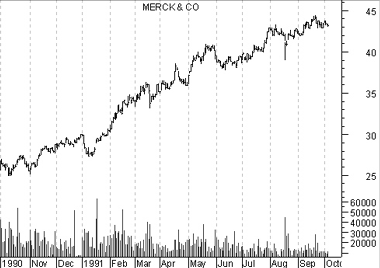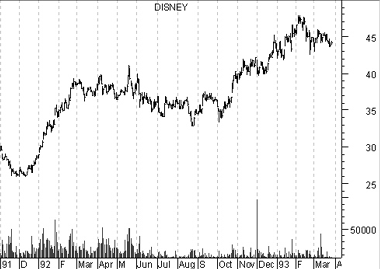|
INTRODUCTION - The Time Element
The Time Element
The discussion that began on page explained the open, high, low, and closing price fields.
This section presents the time element.
Much of technical analysis focuses on changes in prices over time. Consider the effect
of time in the following charts, each of which show a security's price increase from $25 to
around $45.
Figure 43 shows that Merck's price increased consistently over a 12-month time period.
This chart shows that investors continually reaffirmed the security's upward movement.
Figure 43

As shown in Figure 44, Disney's price also moved from around $25 to $45, but it did so
in two significant moves. This shows that on two occasions investors believed the
security's price would move higher. But following the first bidding war, a period of time
had to pass before investors accepted the new prices and were ready to move them higher.
Figure 44

The pause after the rapid increase in Disney's price is a typical phenomena. People
have a difficult time accepting new prices suddenly, but will accept them over time. What
once looked expensive may one day look cheap as expectations evolve.
This is an interesting aspect of
point and figure charts, because point and figure charts
totally disregard the passage of time and only display changes in price.
A Sample Approach
There are many technical analysis tools in this book. The most difficult part of technical
analysis may be deciding which tools to use! Here is an approach you might try.
Determine the overall market condition.
If you are trading equity-based securities (e.g., stocks), determine the trend in interest
rates, the trend of the New York Stock Exchange, and of investor sentiment (e.g., read the
newspaper). The object is to determine the overall trend of the market.
Pick the securities.
I suggest that you pick the securities using either a company or industry you are familiar
with, or the recommendation of a trusted analyst (either fundamental or technical).
Determine the overall trend of the security.
Plot a 200-day (or 39-week) moving
average of the security's closing price. The best buying opportunities occur when the
security has just risen above this long-term moving average.
Pick your entry points.
Buy and sell using your favorite indicator. However,
only take positions that agree with overall market conditions.
Much of your success in technical analysis will come from experience. The goal isn't to
find the holy grail of technical analysis, it is to reduce your risks (e.g., by trading
with the overall trend) while capitalizing on opportunities (e.g., using your favorite
indicator to time your trades). As you gain experience, you will make better, more
informed, and more profitable investments.
"A fool sees not the same tree that a wise man sees."
--William Blake, 1790
|

